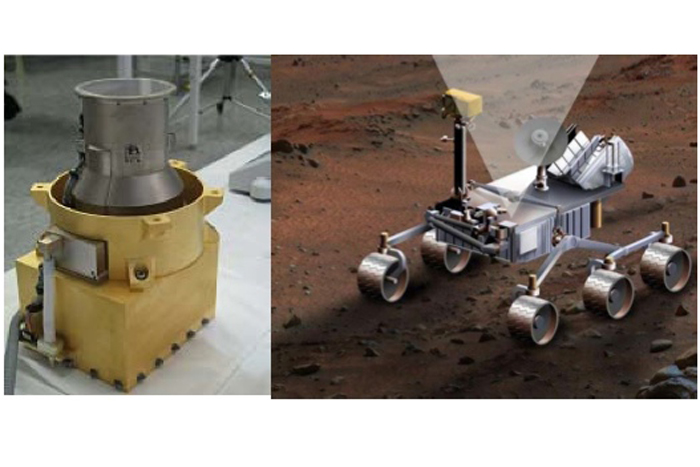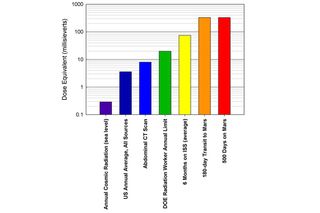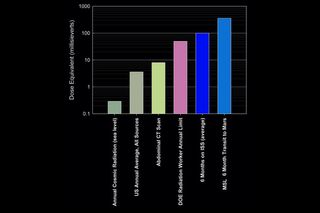Calculated Risks: How Radiation Rules Manned Mars Exploration

Nearly everything we know about the radiation exposure on a trip to Mars we have learned in the past 200 days.
For much longer, we have known that space is a risky place to be, radiation being one of many reasons. We believed that once our explorers safely landed on the surface of Mars, the planet would provide shielding from the ravages of radiation. We didn’t how much, or how little, until very recently. Radiation and its variations impact not only the planning of human and robotic missions, but also the search for life taking place right now.
The first-ever radiation readings from the surface of another planet were published last month in the journal Science. The take-home lesson, as well as the getting-there lesson and the staying-there lesson, is this: don’t forget to pack your shielding. [Mars Radiation Threat to Astronauts Explained (Infographic)]
"Radiation is the one environmental characteristic that we don’t have a lot of experience with on Earth because we’re protected by our magnetosphere and relatively thick atmosphere. But it’s a daily fact of life on Mars," said Don Hassler, the lead author on the paper, "Mars’ Surface Radiation Environment Measured with the Mars Science Laboratory’s Curiosity Rover."

Measuring radiation on Mars
On Earth, we often associate radiation exposure with fallout from catastrophes such as Chernobyl and Fukushima. We sometimes worry over CAT scans, chest X-rays or transcontinental flights. However, according to the Health Physics Society, the biggest source of radiation for most of us, by far, is inhaled radon. The sky above our heads and the earth beneath our feet are typically the least of our worries.
In open space, human beings continuously contend with intense solar and cosmic background radiation. Solar energetic particles (SEPs) and galactic cosmic rays (GCRs) turn a trip to Mars into a six-month radiation shower.
Get the Space.com Newsletter
Breaking space news, the latest updates on rocket launches, skywatching events and more!
The Mars rover Curiosity has allowed us to finally calculate an average dose over the 180-day journey. It is approximately 300 mSv, the equivalent of 24 CAT scans. In just getting to Mars, an explorer would be exposed to more than 15 times an annual radiation limit for a worker in a nuclear power plant.
Data from Curiosity also demonstrated that landing only partially solves the problem. Once on the Martian surface, cosmic radiation coming from the far side of the planet is blocked. This cuts down detected GCRs by half. The protection from strong solar particles, though, is shoddy and inconsistent. Substantial variations in SEPs occur as the meager Martian atmosphere is tussled by solar wind.
"The variability [in radiation levels] was much larger than expected," Hassler said. "[This creates] variability in weekly and monthly dose rates. There are also seasonal variations in radiation."
Study co-author Jennifer Eigenbrode, from the Goddard Institute of Space Studies, described how fluxes in radiation are critical in determining the possibility of life on the Red Planet.
"Radiation is probably the key parameter in determining how much alteration organics are experiencing in the rocks on the surface," Eigenbrode said.
Eigenbrode said this is because the most powerful particles in the air also penetrate the Martian soil. On impacting the surface, the GCRs and strong SEPs from space produce gamma rays and neutrons easily capable of breaking molecular bonds in the soil.
These events may have obliterated all evidence of life close to the surface. The new study estimates that finding intact organic molecules means digging deeper, down a meter or so, and digging for newer evidence, near impact sites where rock has spent less time exposed to the elements. [The Search for Life on Mars (A Photo Timeline)]
"If we find organics on Mars, the circumstance in which we find them [the context of the rocks], the history of the rocks, and the chemistry that we find, will help guide our mission strategy," Eigenbrode said.
Radiation levels measured by Curiosity have given us a better guide on how and where to look for former or current life. Future life, specifically the lives of our astronauts, also hinges upon these radiation measurements.
Fundamentally, "situational awareness is the strategy we have to use going forward," Hassler said. "We can design shelters on the surface to protect the astronauts."
Deep space, the place of greatest exposure, remains an issue.
"Perhaps one of the areas they would be most vulnerable would be during a spacewalk [on the way] to Mars."

Predicting space weather
In transit and on the planet, surviving space means predicting space weather. Space weather forecasting is a relatively new field, but one that's proving to be critical to all space missions.
Space weather prediction involves forecasting solar flares, coronal mass ejections, and geomagnetic storms. These highly energetic events emanate from the sun. When they cross the orbit of a planet, the same SEPs attacking organics can spell disaster for satellites, space stations, astronauts and the communication systems they all depend upon.
"To protect our satellites is becoming more and more important here on Earth," Hassler said.
Protecting satellites and people around Earth and Mars likely involves setting up two separate systems. Using Earth-based technologies to predict the radiation levels on Mars isn’t the best choice. The distance and opposition of the planets compounds the problem. When Mars is on the far side of the sun, it isn’t even an option.
"When we send astronauts to Mars, we will have to do our own space weather monitoring from [Mars]," Hassler said.
From beneath the shelter of Earth’s ample atmosphere, we continue to receive daily updates from Curiosity. Its 3-pound Radiation Assessment Detector (RAD) instrument informs us about surface radiation events, particle type and relative frequencies. For now, RAD is the only way that we can study Martian radiation and make plans for the future.
In the future, what we’ve learned from RAD will be used to better look for life on the surface, to design suits and habitats, to plan extravehicular activities. Because of what we have learned, we can begin to establish weather prediction systems. We can tell explorers that there is an increased risk of cancer associated with a trip to Mars (approximately 5 percent over a lifetime).
In these ways, radiation rules the past, present and future of effective planetary exploration. Thanks to RAD measurements and the resulting analysis, we can begin to write a survival guide for life on Mars.
Funding by Goddard and JPL.
This story was provided by Astrobiology Magazine, a web-based publication sponsored by the NASA astrobiology program. Follow us @Spacedotcom, Facebook or Google+. Published on SPACE.com.
Join our Space Forums to keep talking space on the latest missions, night sky and more! And if you have a news tip, correction or comment, let us know at: community@space.com.










